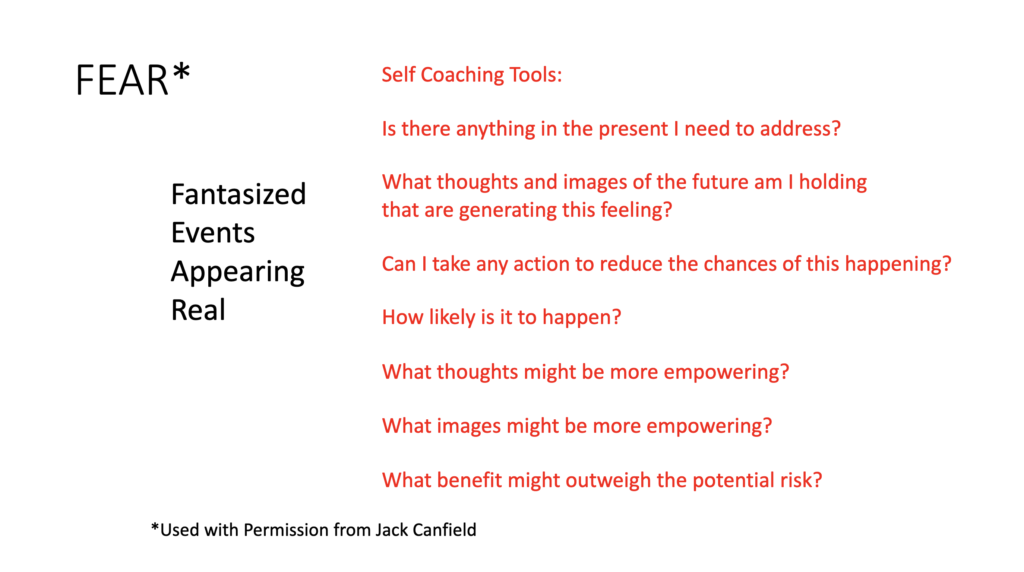 Dr. Ivan Joseph, a varsity soccer coach and head of athletics at Ryerson University, gave an outstanding TEDx talk on thinking about self-confidence as a skill that can be developed with practice, repetition, and paying close attention to self-talk. If you think about self-confidence this way, anyone can learn it with enough practice. I find that truly freeing.
Dr. Ivan Joseph, a varsity soccer coach and head of athletics at Ryerson University, gave an outstanding TEDx talk on thinking about self-confidence as a skill that can be developed with practice, repetition, and paying close attention to self-talk. If you think about self-confidence this way, anyone can learn it with enough practice. I find that truly freeing.
That got me to thinking: “What if you approach your fear of doing something new using this same methodology? What if ‘dealing with fear’ was actually a skill we can all master?”
So I thought about how we might develop this skill.
One of my mentors, Jack Canfield, characterizes fear as “Fantasized Events Appearing Real.” And with that as a definition, what I am fearing is almost always in the future, not something I am experiencing right now. Now I get that is not always the case. If I am being attacked with a knife, then something is happening right now. My fear is helping to get me going to defend myself.
But the fear that often stops us from asking for help, or trying something new, or risking a delicate conversation with a friend is a fear of what MIGHT happen in the future. It has not happened yet. So, in these cases, we are fantasizing about events that have not occurred, and frankly may not occur, even if we took the action that we were hesitating to take.
If we pay attention to our self-talk, we can likely get in touch with exactly what that fantasized event is: “What if I fall and hurt myself as I am learning to rock climb? What would John think if I asked him for help? What if I failed when I tried to run my own business? What if my friend Sue gets angry when I bring this subject up?” All of these potential outcomes are fantasized events in the future, and they are appearing real to me now.
In summary, paying attention to our self-talk could help us get clear about what it is we might be fearing. And then the repetitive practice would become what we do with this fantasized event. If we had a standard set of questions we always went through in situations like this, we would be practicing on a consistent basis what we could do about these fantasized situations:
1. What is the likelihood that this event will actually occur? In the examples I shared above, the most likely outcome is probably getting hurt when learning to rock climb.
2. If the outcome has a high probability, is there anything I can do to mitigate it or lessen the impact? In the rock climbing example, I could get instruction on how to climb properly and use all the suggested safety equipment.
FEAR3. If there is nothing I can do, do I even care? For example, do I really care what John thinks? Or put another way, is the benefit I might get worth the potential downside?
This rigorous approach to challenging our self-talk can help us get clear on what we are fantasizing. Where there is something we can do, we can actually go do it.
But then we need to practice different self-talk or come up with different thoughts or images that would be more empowering .I suggest that you initially work this out with someone who knows and cares about you, like your peer coach. But then the practice is really up to you. You just need the prompt to actually try it on a routine basis. So what if you kept a standard set of questions on a 3 by 5 card on your desk:
What image or thought of a fantasized event in the future is generating this feeling of fear?
How likely is that to occur?
Is there anything I can do about it so I don’t have to worry about it?
Do I really care about whether this event happens?
What thoughts or images might be more empowering? Practice these with visioning every day and before taking action on your goal.
With this repetition and practice, I am convinced we can develop the “skill of dealing with fear.”